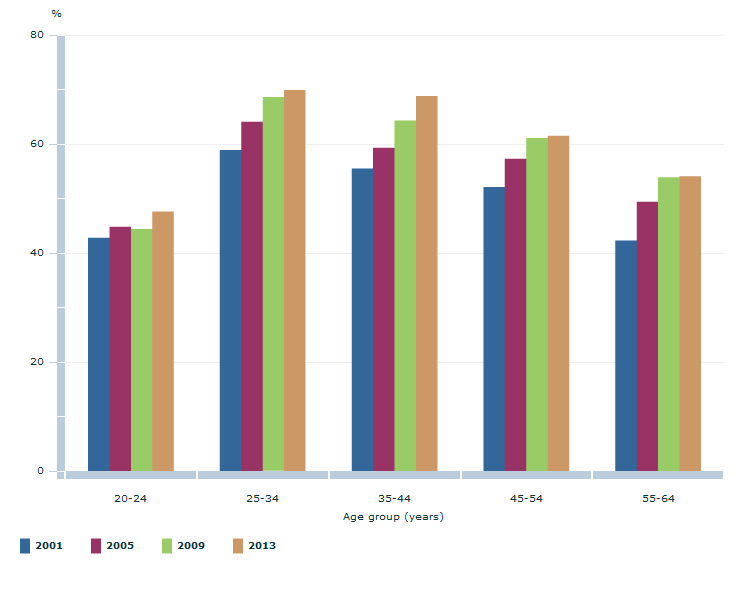6227.0 - Education and Work, Australia, May 2013  Quality Declaration
Quality Declaration
ARCHIVED ISSUE Released at 11:30 AM (CANBERRA TIME) 29/11/2013
Page tools:
 Print Page Print Page
 Print All Print All
| ||
LEVEL OF HIGHEST NON-SCHOOL QUALIFICATION The proportion of people aged 15-64 years with a non-school qualification increased from 47% in 2001 to 57% in 2013, with the proportion of people with a Bachelor Degree or above increasing from 17% to 25%. Over the same period, the proportion of people whose highest non-school qualification was an Advanced Diploma or below only increased from 29% to 32%. The proportion of people aged 55-64 years with a non-school qualification increased from 42% in May 2001 to 54% in May 2013 while the proportion for people aged 25-34 years increased from 59% to 70%. (Table 8) GRAPH 4: PROPORTION OF PEOPLE AGED 20–64 YEARS WITH A NON-SCHOOL QUALIFICATION, BY AGE GROUP, MAY 2001 TO MAY 2013  Source(s): Education and Work, Australia, May 2013 In May 2013, a similar number of males and females aged 15-64 years had a non-school qualification (4.4 million for both males and females). People who were Australian or New Zealand citizens (56%) were less likely to have a non-school qualification than people who were not citizens (67%). A similar proportion of people with permanent visas (67%) and temporary visas (69%) had a non-school qualification. Temporary residents who were not here on student visas (77%) were the most likely to have a non-school qualification. (Table 9) Among the 8.9 million people aged 15-64 years with a non-school qualification, the most common main fields of study for the highest non-school qualification were Management and commerce (2.1 million or 24%) and Engineering and related technologies (1.4 million or 16%). (Table 12) LEVEL OF HIGHEST EDUCATIONAL ATTAINMENT Just over a quarter (27%) of people aged 15-64 years reported their highest educational attainment as Year 11 or below and 20% reported Year 12. A further 18% had a highest level of attainment of a Certificate III or IV, 17% had a Bachelor degree, 2.7% had a Graduate Diploma or Graduate Certificate and 5.0% had a Postgraduate Degree. Almost two-fifths (39%) of people in the ACT had a Bachelor Degree or above as their highest level of educational attainment, the highest proportion of all states and territories. (Tables 14) A higher proportion of males than females reported their level of highest educational attainment as Certificate III or IV, with 23% of all males reporting this qualification, compared with 14% of females. However, a higher proportion of females (27%) than males (22%) had obtained a Bachelor Degree or higher qualification. (Table 14) In May 2013, of the 1.8 million people aged 65-74 years, 385,800 (21%) were employed. Almost a quarter (24%) of employed 65-74 year olds had a Bachelor Degree or above compared with 12% of 65-74 year olds who were not employed. Over half (56%) of people 65-74 years who were not employed had a highest educational attainment below Year 12, compared with 37% of people 65-74 years who were employed. (Table 15) Document Selection These documents will be presented in a new window.
|
||
